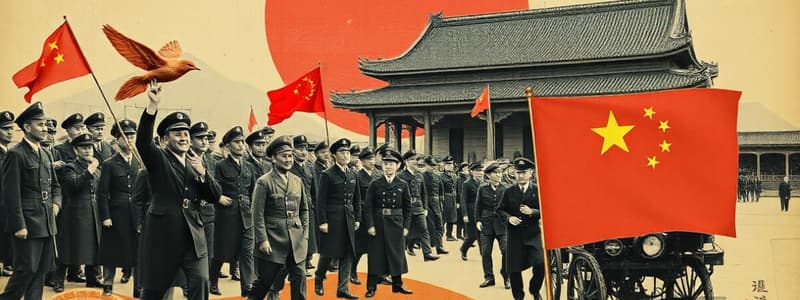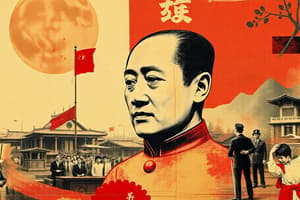Podcast
Questions and Answers
What fundamental difference in ideology led to the initial split between Jiang Jieshi's Nationalists and the Chinese Communists?
What fundamental difference in ideology led to the initial split between Jiang Jieshi's Nationalists and the Chinese Communists?
- The Nationalists supported foreign intervention, while the Communists advocated complete isolationism.
- The Nationalists prioritized individual liberties, while the Communists emphasized collective ownership.
- The Nationalists believed in rapid industrialization, while the Communists favored agrarian reform.
- The Nationalists aimed to establish a democratic republic, while the Communists sought a socialist state. (correct)
What critical miscalculation did the government in Beijing make in 1917 when they declared war against Germany?
What critical miscalculation did the government in Beijing make in 1917 when they declared war against Germany?
- They did not anticipate the internal political repercussions of joining the war.
- They failed to secure guarantees of territorial return from the Allies. (correct)
- They underestimated the strength of the German military.
- They overestimated their own military capabilities.
Which of Sun Yixian's 'Three Principles of the People' directly addressed the issue of foreign influence in China during the early 20th century?
Which of Sun Yixian's 'Three Principles of the People' directly addressed the issue of foreign influence in China during the early 20th century?
- Democracy
- People's Livelihood
- Socialism
- Nationalism (correct)
How did Mao Zedong adapt Marxist ideology to the Chinese context, differentiating it from Lenin's approach in Russia?
How did Mao Zedong adapt Marxist ideology to the Chinese context, differentiating it from Lenin's approach in Russia?
Why was the Long March a pivotal event in the rise of Chinese communism despite the immense suffering and loss of life?
Why was the Long March a pivotal event in the rise of Chinese communism despite the immense suffering and loss of life?
What specific action by Yuan Shikai triggered widespread local revolts and undermined the democratic ideals of the 1911 revolution?
What specific action by Yuan Shikai triggered widespread local revolts and undermined the democratic ideals of the 1911 revolution?
What was the primary reason for Sun Yixian's disillusionment with Western democracies following the establishment of the Republic of China?
What was the primary reason for Sun Yixian's disillusionment with Western democracies following the establishment of the Republic of China?
What key factor enabled the Japanese to exploit China's internal instability in the 1930s, ultimately leading to their invasion of Manchuria?
What key factor enabled the Japanese to exploit China's internal instability in the 1930s, ultimately leading to their invasion of Manchuria?
How did the May Fourth Movement represent a turning point in Chinese intellectual thought and its view on Western ideals?
How did the May Fourth Movement represent a turning point in Chinese intellectual thought and its view on Western ideals?
In what way did Jiang Jieshi's background and the composition of his followers influence the policies and direction of the Kuomintang?
In what way did Jiang Jieshi's background and the composition of his followers influence the policies and direction of the Kuomintang?
Which of the following actions by Mao Zedong directly contributed to the growing support for the Chinese Communist Party among the peasant population?
Which of the following actions by Mao Zedong directly contributed to the growing support for the Chinese Communist Party among the peasant population?
What was the strategic significance of Mao Zedong's advocacy for guerrilla warfare during the Chinese Civil War?
What was the strategic significance of Mao Zedong's advocacy for guerrilla warfare during the Chinese Civil War?
How did the Japanese invasion of China in 1937 impact the relationship between the Chinese Communist Party and the Nationalist government?
How did the Japanese invasion of China in 1937 impact the relationship between the Chinese Communist Party and the Nationalist government?
Which long-term effect did the Shanghai Massacre have on the relationship between the Kuomintang and the Chinese Communist Party?
Which long-term effect did the Shanghai Massacre have on the relationship between the Kuomintang and the Chinese Communist Party?
What was the underlying tension between the Nationalists' modernization efforts and the views of those who 'feared change' in early 20th century China?
What was the underlying tension between the Nationalists' modernization efforts and the views of those who 'feared change' in early 20th century China?
Flashcards
Main Idea: Revolution
Main Idea: Revolution
After the fall of the Qing dynasty, nationalist and Communist movements struggled for power in China.
Kuomintang
Kuomintang
The Nationalist Party in China, advocating modernization and nationalization.
Sun Yixian
Sun Yixian
Led the Kuomintang and aimed to establish a modern government based on the "Three Principles of the People".
May Fourth Movement
May Fourth Movement
Signup and view all the flashcards
Mao Zedong
Mao Zedong
Signup and view all the flashcards
Jiang Jieshi
Jiang Jieshi
Signup and view all the flashcards
Long March
Long March
Signup and view all the flashcards
Qing Dynasty Overthrow
Qing Dynasty Overthrow
Signup and view all the flashcards
Three Principles of the People
Three Principles of the People
Signup and view all the flashcards
Yuan Shikai
Yuan Shikai
Signup and view all the flashcards
China in World War I
China in World War I
Signup and view all the flashcards
CCP
CCP
Signup and view all the flashcards
"Swimming in the Peasant Sea"
"Swimming in the Peasant Sea"
Signup and view all the flashcards
Shanghai Massacre
Shanghai Massacre
Signup and view all the flashcards
Chinese Nationalists and Communists
Chinese Nationalists and Communists
Signup and view all the flashcards
Study Notes
Imperial China Collapses
- After the fall of the Qing dynasty, Nationalist and Communist movements struggled for power. The seeds of communism were planted at this time.
Setting the Stage
- China faced years of humiliation at the hands of outsiders in the early 1900s.
- Foreign countries controlled China's trade and economic resources.
- Many Chinese people believed modernization and nationalism were key to survival.
- They wanted to build up the army and navy, construct modern factories, and reform education.
Nationalists Overthrow Qing Dynasty
- The Kuomintang (Nationalist Party) pushed for modernization and nationalization.
- Sun Yixian was the first great leader of the Kuomintang.
- In 1911, the Revolutionary Alliance succeeded in overthrowing the last emperor of the Qing dynasty, which had ruled China since 1644.
Shaky Start for the New Republic
- In 1912, Sun Yixian became president of the new Republic of China.
- Sun hoped to establish a modern government based on the "Three Principles of the People": nationalism, democracy, and people's livelihood.
- Sun considered nationalism vital but lacked the authority and military support to secure national unity.
- Yuan Shikai betrayed the democratic ideals of the revolution, sparking local revolts after Sun turned over the presidency to him.
- After Yuan Shikai died in 1916, civil war broke out, and real authority fell into the hands of provincial warlords or powerful military leaders.
World War I
- In 1917, the government in Beijing declared war against Germany, hoping the Allies would return control of Chinese territories.
- The Treaty of Versailles gave those territories to Japan.
- On May 4, 1919, over 3,000 angry students gathered in the center of Beijing, and demonstrations spread to other cities, exploding into the May Fourth Movement.
- The May Fourth Movement showed the Chinese people's commitment to establishing a strong, modern nation.
- Many young Chinese intellectuals turned against Sun Yixian's belief in Western democracy in favor of Lenin's brand of Soviet communism.
The Communist Party in China
- In 1921, a group met in Shanghai to organize the Chinese Communist Party.
- Mao Zedong, an assistant librarian at Beijing University, was among its founders and would become China's greatest revolutionary leader.
- Mao Zedong developed his own brand of communism, envisioning bringing revolution to a rural country.
Lenin Befriends China
- Sun Yixian and his Nationalist Party set up a government in south China while the Chinese Communist Party was forming.
- Lenin seized the opportunity to help China's Nationalist government, sending military advisers and equipment to the Nationalists in return for allowing Chinese Communists to join the Kuomintang.
Peasants Align with the Communists
- After Sun Yixian died in 1925, Jiang Jieshi headed the Kuomintang.
- The followers of Jiang Jieshi feared the Communists' goal of creating a socialist economy modeled after the Soviet Union's.
- Jiang's government became steadily less democratic and more corrupt, causing many peasants to support the Chinese Communist Party.
- Mao divided land that the Communists won among the local farmers to enlist their support.
Nationalists and Communists Clash
- Jiang initially put aside his differences with the Communists and fought the warlords together.
- Nationalist troops and armed gangs moved into Shanghai in April 1927, killing many Communist leaders and trade union members.
- In 1928, Jiang became president of the Nationalist Republic of China, receiving formal recognition from Great Britain and the United States.
- The Soviet Union did not recognize the new government because of the slaughter of Communists at Shanghai.
Civil War Rages in China
- By 1930, the Nationalists and Communists were fighting a bloody civil war.
- Mao and other Communist leaders established themselves in the hills of south-central China, recruiting the peasants to join his Red Army.
- Jiang gathered an army of at least 700,000 men in 1933 and surrounded the Communists' mountain stronghold.
The Long March
- Communist Party leaders realized they faced defeat, beginning a hazardous, 6,000-mile-long journey called the Long March.
- Between 1934 and 1935, thousands of Communist forces died from hunger, cold, exposure, and battle wounds.
- After a little more than a year, Mao and the seven or eight thousand Communist survivors settled in caves in northwestern China.
Civil War Suspended
- As civil war raged between Nationalists and Communists, Japan invaded China.
- Japanese forces took advantage of China's weakening situation in 1931, invading Manchuria.
- In 1937, the Japanese launched an all-out invasion of China, causing massive bombings and destruction.
- The Japanese threat forced an uneasy truce between Jiang's and Mao's forces as Nationalists and Communists temporarily united to fight the Japanese.
Studying That Suits You
Use AI to generate personalized quizzes and flashcards to suit your learning preferences.




